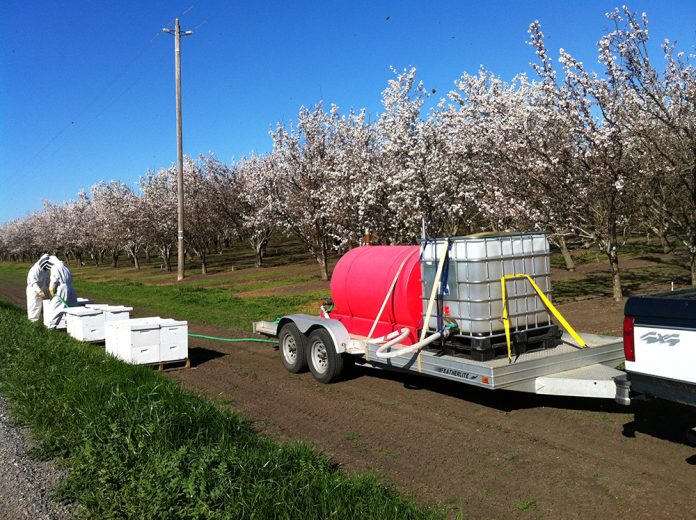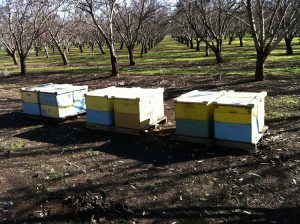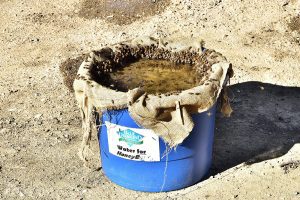
Considering that pollination services can present a significant portion of almond production costs, growers should be aware of steps they can take to provide the healthiest possible habitat for honeybees while hives are in their orchards.
Interviews with pollinator researchers, beekeepers and almond growers show that most are on the same page when it comes to implementing practices to promote honeybee health. The time spent in almond orchards impacts hive health throughout the year. Beekeepers want to retrieve healthy, active hives at the end of bloom. Growers want to be sure bees were active during bloom and positively impact production. While weather during bloom can’t be controlled, nutrition sources, water, prevention of pesticide exposure and security can definitely be part of a successful almond pollination plan each year.

Communication between growers and beekeepers also plays a part in healthy hive habitat, said Rory Crowley, director of habitat programs for Project Apis m. He advises that all aspects of pollination services, both what the beekeeper is delivering and responsibilities of the almond grower, are spelled out in a contract well before bees are delivered to the orchard. He also notes that almond growers who take the initiative and provide a healthy habitat for pollinators in their orchards may be rewarded with healthy, active hives.
Many growers and beekeepers have long-term pollination relationships, said Elena Nino, UC Davis honeybee researcher. She noted both old and new almond growers and beekeepers need to know the advantages of providing a “buffet for bees in and around the orchard.”
The following tips were provided by Nino, Crowley, Almond Board of California’s best management practices and Steve House, director of operations for California Almond Pollination Service Inc.

1. Nutrition
Not all growers are aware of the advantages to honeybee health provided by blooming cover crops in orchards, said Nino.
Forage plantings, including cover crops and hedgerows, can provide a good source of nutrition that encourages vigorous honeybee activity in the orchard. House notes that almond pollen is rich in proteins and amino acids, but the duration of availability is short.
While the window for planting 2023 supplemental forage has closed, growers and orchard managers can begin planning for the next planting opportunity. Crowley said the Apis m. program Seeds for Bees encourages growers to support honeybee health by planting cover crops in orchards and, if possible, in surrounding areas to provide supplemental forage before, during and after bloom. Research has shown, he said, that almond orchards where cover crops are planted to bloom prior to almond bloom provide nutrition to foraging bees and result in increased bee activity during pollination. Not only does the supplemental forage provide nutrients to build healthy and vigorous colonies, Crowley said, but there is the potential for increased bee activity during pollination that may result in increased nut production. Last year, the Seeds for Bees program provided seeds for 8,419 acres of cover crops in California. An estimated 80% of the acres were almond orchards, Crowley said.
2. Water
This simple yet vital provision allows bees to stay healthy and strong during the almond bloom. Access to water should be within a quarter mile of the hives. It is recommended by Project Apis m. that a half gallon of water is available for each hive or one 55-gallon drum for every 100 hives or a 5-gallon bucket for every 10 hives while they are in the orchard.
Since bees cannot swim, a ‘landing’ area at the water site is necessary for successful water collection. Blue Diamond Growers launched a pilot program in 2019 that gives almond grower members tubs with burlap at the top that acts as a landing pad for bees while they drink. Mel Machado, grower relations for Blue Diamond, said the program became official in 2021 with plans to scale up the program to have more growers participate.
Apis m. recommends placing water near hives when they arrive in the orchard. Containers should be clean, and the burlap is draped over the sides to allow water to wick up. Water should be changed as needed. Research has shown that dead and decaying organic matter leaches nutrients into the water that bees need. Depending on the needs of the hives, bees prefer water with sodium, calcium, potassium and magnesium.
3. Bee-Friendly IPM
An environment safe from pesticide contamination not only keeps bees healthy, but it allows development of healthy larvae and brood in the hives.
Best management practices from the Almond Board of California stress that applications of fungicides be only done in late afternoon or evening. Crowley advised that nighttime spraying is probably the best choice, noting that the bees are much less likely to come into contact with the spray droplets. Even spraying with water during the day interrupts flight patterns of bees and makes them less likely to carry out effective pollination, Crowley said.
Growers, along with PCAs and applicators should also avoid tank mixing products during bloom until more is known about effects on honeybees. This advice also includes adjuvants, Crowley said, because not enough is known about the effects of the many adjuvants on the market on honeybees.
4. Communication
Clear communication between growers and beekeepers on the specifics of a pesticide application is important. The BeeWhere program evolved to facilitate communication between beekeepers and applicators.
California law requires beekeepers to register hive locations with their local County Agricultural Commissioners. The BeeWhere program began in 2017 and offers a GIS mapping system where users can mark hive locations with a mobile app. That allows applicators to access the general number of hives within a mile of a permit when a PCA is considering a pesticide application. Applicators can access the hive locations for a 48-hour notification.
5. Hive Placement
This part of a healthy habitat can be crucial to optimal pollination activity. Nino said that hives placed where they are exposed to early morning sun will help add flight hours during pollination.
Access to hives by beekeepers is important, but so is security. Every year there are reports of hives stolen out of orchards during almond bloom. Hives placed next to roads can be vulnerable to theft, but those sites also offer easier access.
Predators can be an issue in some orchards. House notes that on the valley floor, wasps, meat bees, mice, swallows and skunks all eat honey and young bees, larvae and beeswax. While it is difficult to avoid all depredation, choosing hive sites that are free of obvious signs of predators can help maintain hive security.
Where hives are placed in an orchard as well as when they arrive and leave is often spelled out in a pollination contract, but Nino notes that some sites better serve bee health than others.










